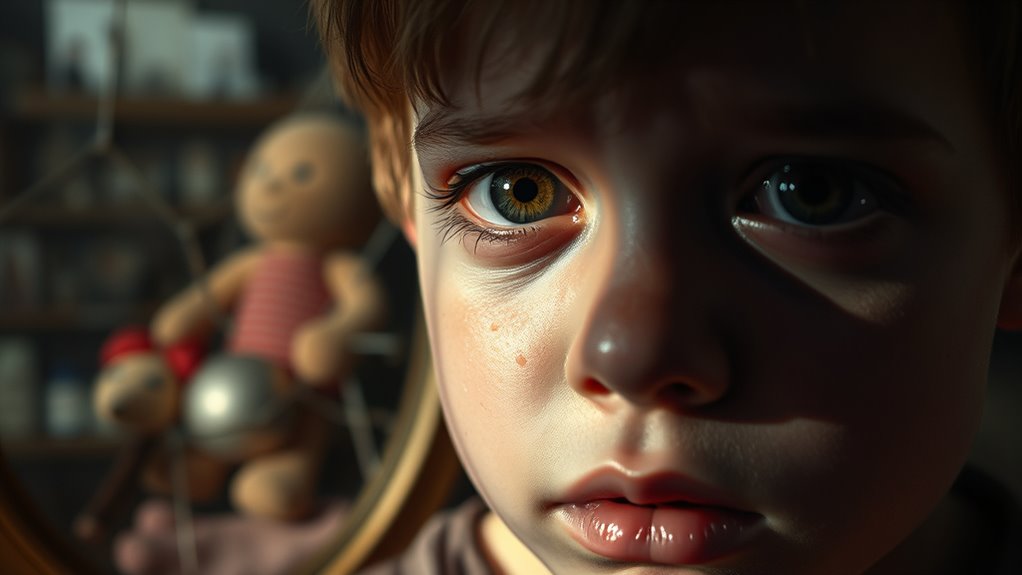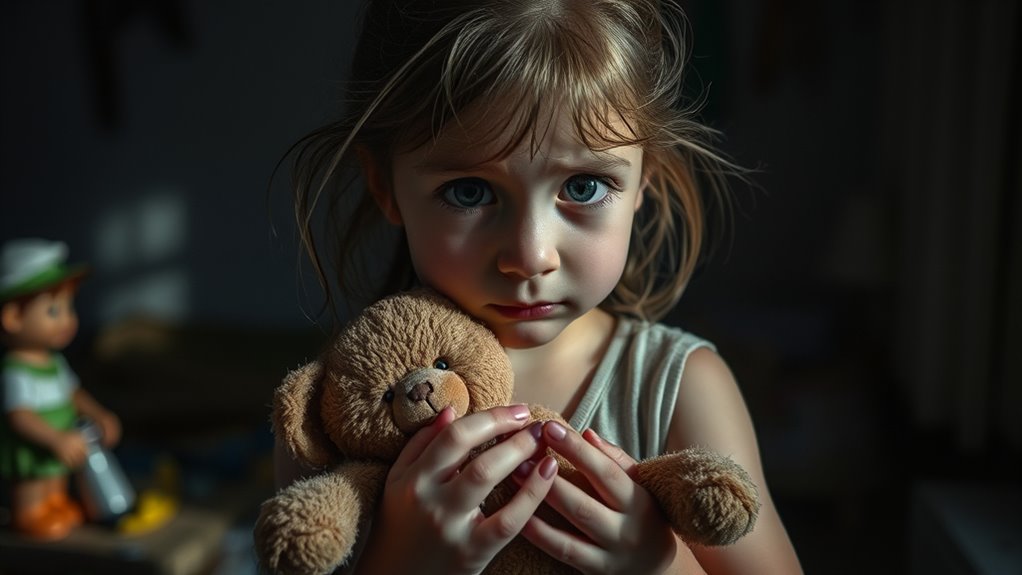Childhood trauma, like abuse or neglect, can profoundly influence whether you develop borderline personality disorder (BPD). These early experiences disrupt emotional growth, impair your sense of self, and can cause lasting changes in brain areas responsible for emotion regulation and impulse control. If trauma goes unaddressed, it increases your risk of difficulties with relationships and emotional stability. Understanding how trauma impacts you is key, and exploring further can provide insights into healing and managing BPD effectively.
Key Takeaways
- Childhood abuse and neglect significantly increase the risk of developing Borderline Personality Disorder (BPD).
- Traumatic early experiences impair emotional regulation and self-identity, contributing to BPD symptoms.
- Childhood trauma can alter brain structures involved in impulse control and emotional management.
- Early signs of BPD include emotional instability, fear of abandonment, and impulsivity linked to trauma history.
- Trauma-focused therapies like DBT help improve emotional regulation and support recovery in individuals with BPD.
Understanding Borderline Personality Disorder

Borderline Personality Disorder (BPD) is a mental health condition marked by emotional instability, difficulty maintaining stable relationships, and impulsive behaviors. It often begins in late adolescence or early adulthood, influenced by early life experiences like childhood trauma or abuse.
Trauma and BPD are closely linked, with trauma symptoms contributing to the development of BPD. You may experience intense emotions and struggle with emotional dysregulation, which hampers your ability to manage feelings effectively. Emotional dysregulation is a central feature that affects many aspects of daily life and interpersonal relationships. Childhood trauma can significantly impact brain development and emotional regulation capacities, increasing vulnerability to BPD. Understanding how early life experiences influence emotional regulation can help in developing effective treatment strategies.
This emotional turbulence affects your self-identity and relationships. Understanding BPD involves recognizing how childhood trauma impacts emotional regulation and contributes to impulsivity.
While the core features include fear of abandonment and mood swings, effective treatments can help you learn healthier ways to cope and improve your mental health over time.
The Impact of Childhood Abuse and Neglect

Childhood abuse and neglect profoundly affect emotional development, especially when they involve physical, emotional, or sexual maltreatment. These early traumatic experiences, such as emotional neglect or maltreatment, often lead to lasting emotional trauma.
When caregivers fail to provide consistent support, it results in developmental disruption and increased risk of BPD. Studies show that around 50-60% of individuals with BPD have experienced childhood sexual abuse, and emotional neglect markedly impairs emotional regulation and self-identity.
Using tools like the childhood trauma questionnaire, researchers identify how early traumatic experiences shape maladaptive coping mechanisms. This trauma hampers social and emotional growth, setting the stage for instability and intense emotional responses characteristic of BPD. Understanding the best anime movies and animated films that touch hearts can provide insight into emotional expression and healing.
The impact of childhood abuse and neglect is a critical factor in understanding this disorder’s origins.
How Trauma Shapes Brain Development and Emotions

Have you ever wondered how early traumatic experiences can shape the way your brain processes emotions? Trauma during early childhood can disrupt brain development, especially in regions like the amygdala and prefrontal cortex, which are essential for emotion regulation.
Early childhood trauma can fundamentally alter your brain’s emotional processing and regulation.
These experiences often alter neural connectivity, impairing the neural pathways responsible for managing impulses and emotions. When trauma dysregulates the HPA axis, cortisol levels rise abnormally, affecting brain structure and function.
This disruption hampers emotional regulation, making you more prone to emotional dysregulation and mood instability. Early trauma can also interfere with neurotransmitter systems, increasing vulnerability to emotional challenges later in life.
Ultimately, these changes hinder social and emotional learning, fostering maladaptive thought patterns and difficulty managing intense emotions.
Recognizing Early Signs and Risk Factors

Recognizing early signs of BPD can be crucial for timely intervention, especially since many of these behaviors stem from past trauma. Childhood trauma, such as neglect or abuse, often manifests as emotional instability and intense fear of abandonment.
These early signs of BPD include impulsivity, unstable relationships, and feelings of emptiness, which are linked to trauma and BPD. Children who experience childhood abuse or invalidating environments may struggle with emotional regulation and self-identity, increasing risk factors for developing BPD later in life.
Being aware of these warning signs allows for early intervention, which can markedly improve outcomes. Understanding how traumatic experiences influence emotional responses helps you identify at-risk individuals and seek appropriate support before patterns become deeply ingrained.
Approaches to Treatment and Support for Trauma-Related BPD

Effective treatment for trauma-related BPD often combines evidence-based therapies with extensive support systems. You’ll find that trauma-focused therapy, such as dialectical behavior therapy (DBT) and mentalisation-based treatment, helps improve emotion regulation and address unresolved childhood trauma. Incorporating proper hamster care practices demonstrates the importance of a comprehensive approach to well-being, which can be similarly applied to trauma recovery. Early intervention is vital to prevent long-term complications. A thorough treatment plan typically includes:
- A multidisciplinary mental health team providing ongoing psychotherapy and trauma-informed care. Recognizing the significance of legislative guidelines can inform treatment options and legal considerations related to mental health. Understanding evidence-based approaches ensures that interventions are tailored to individual needs and backed by current research. Additionally, staying informed about clinical protocols can optimize treatment efficacy and safety.
- Community support networks that reinforce skills learned during therapy.
- Specialized programs, like those at The Wave Clinic, offering residential and outpatient options for skill development and life path exploration.
Additionally, understanding store hours can be essential for coordinating various aspects of recovery, such as scheduling appointments and accessing resources in your community.
Frequently Asked Questions
What Type of Childhood Trauma Causes BPD?
You might wonder what childhood trauma causes BPD. It’s often linked to experiences like physical, emotional, or sexual abuse, especially when combined with emotional neglect.
Inconsistent caregiving, emotional invalidation, or witnessing violence can also contribute.
When you face abandonment or lose a caregiver, it increases your risk.
These traumatic events disrupt your sense of stability, shaping emotional regulation issues characteristic of BPD.
At What Age Does BPD Peak?
You might find it interesting that BPD symptoms hit their peak between ages 18 and 25. During this time, you could experience the most intense emotional swings and impulsive behaviors.
Neurodevelopmental and hormonal changes contribute to this surge.
If you’re in this age range, know that while symptoms can be strong now, they often stabilize or lessen with time, helping you manage them better as you grow older.
Does Borderline Personality Disorder Have Strongest Link to Childhood Trauma?
You might wonder if BPD is strongly linked to childhood trauma. Research shows that about 80% of people with BPD experienced some form of childhood abuse or neglect.
This trauma often disrupts emotional regulation and attachment patterns, increasing the risk of developing BPD. While not everyone with BPD has a traumatic background, trauma is a significant factor that can contribute to the disorder’s emergence and severity.
What Does BPD Look Like in Childhood?
Imagine a stormy sky—your child’s emotions swirl wildly, shifting rapidly like lightning flashes. They may act impulsively, engage in risky behaviors, or fear abandonment like a shadow lurking nearby.
Mood swings, feelings of emptiness, and fragile self-identity are common, making trust hard to build. Their hypersensitivity to criticism causes emotional outbursts, and they struggle to manage feelings, often feeling lost amid the chaos they can’t control.
Conclusion
Think of your mind like a delicate garden; childhood trauma can be like harsh storms that damage the fragile plants. But with understanding, support, and therapy, you can nurture new growth and restore beauty. Remember, early intervention is like planting strong roots—giving you a chance to heal and flourish. You’re not alone in this journey, and with the right help, you can transform your past struggles into resilience and strength.









